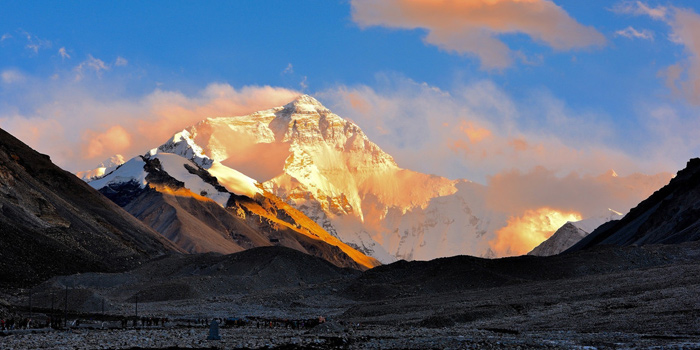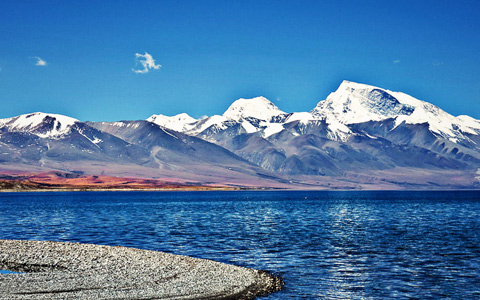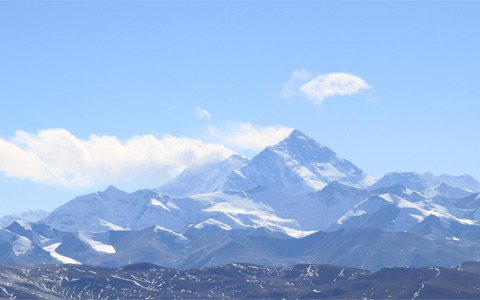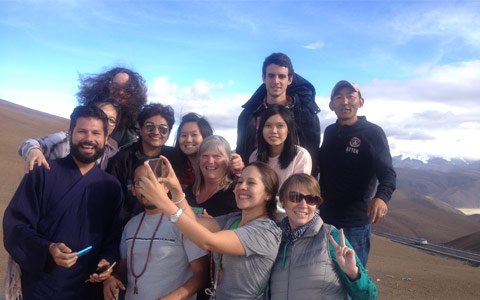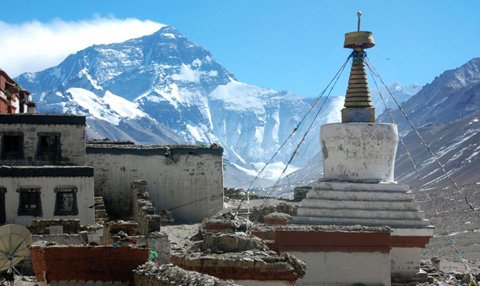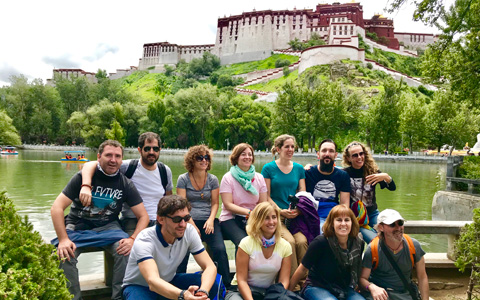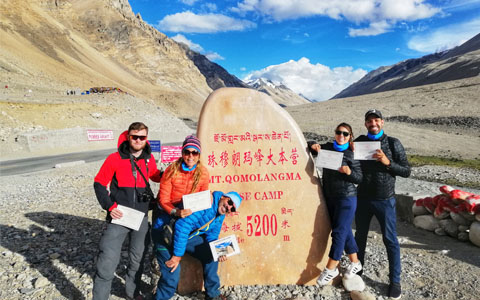Tibetan Nomads: Guide to The Unique Nomadic Tribe Living on the Tibetan Plateau
On the vast Tibetan Plateau, Tibetan nomads lead an extraordinary way of life. For generations, they have roamed this high-altitude landscape, deeply connected to nature and their herds. In this guide, we delve into their unique world. Join us on a journey through the rugged Tibetan Plateau to learn about their customs, sustainable practices, and changing ways of life.
Daily Life of a Tibetan Nomad Family Living in Altitude of 4800 Meters
 Who are the Tibetan Nomads? How Many Nomads are there in Tibet?
Who are the Tibetan Nomads? How Many Nomads are there in Tibet?
 Why Tibetan Nomads are Unique from other Tribes?
Why Tibetan Nomads are Unique from other Tribes?
 What is the Traditional Lifestyle of Tibetan Nomads?
What is the Traditional Lifestyle of Tibetan Nomads?
 What about the Modern Life of Tibetan Nomads?
What about the Modern Life of Tibetan Nomads?
 How to Visit a Tibetan Nomad Tent?
How to Visit a Tibetan Nomad Tent?
 How to Encounter Tibetan Nomads during a Tibet Tour?
How to Encounter Tibetan Nomads during a Tibet Tour?
Who are the Tibetan Nomads? How Many Nomads are there in Tibet?
Tibetan nomads are a distinct group of people who have traditionally lived a nomadic lifestyle in the Tibetan Plateau. They primarily rely on livestock herding, including yaks, sheep, and goats, for their sustenance and livelihoods.
 Tibetan nomads primarily rely on livestock herding for their sustenance and livelihoods.
Tibetan nomads primarily rely on livestock herding for their sustenance and livelihoods.
It is believed that Tibetans originated from the ancient Qiang People, who were nomads in ancient China. The intermarriage between the Qiang People and local tribes on the plateau's edges led to the emergence of the modern Tibetan people. Due to the challenging environment, extreme altitudes, and a lack of convenient transportation, Tibetans have depended on pastoralism for their survival for centuries.
As a result, Tibetans are renowned for their resilience as nomads. The exact number of Tibetan nomads remaining on the plateau is relatively unknown, but it's estimated to be roughly 25% of Tibet's population. Nevertheless, they can frequently be observed on the plains and near major water sources, with their herds and flocks grazing on the lush grasses of the plateau.
Why Tibetan Nomads are Unique from other Tribes?
What truly distinguishes Tibetan nomads from nomads worldwide is the extreme altitude and unpredictable weather. Living in central Tibet is relatively comfortable compared to life in the wild northern regions.
In Nagchu, where most Tibetan nomads live, the climate is so severe that not only is the oxygen content less than half that at sea level, but the annual average temperature remains below freezing, with the lowest recorded temperature reaching minus 42 degrees. To make matters worse, this fragile ecosystem is plagued by sporadic natural disasters such as hail, heavy snowfall, and steppe degradation.
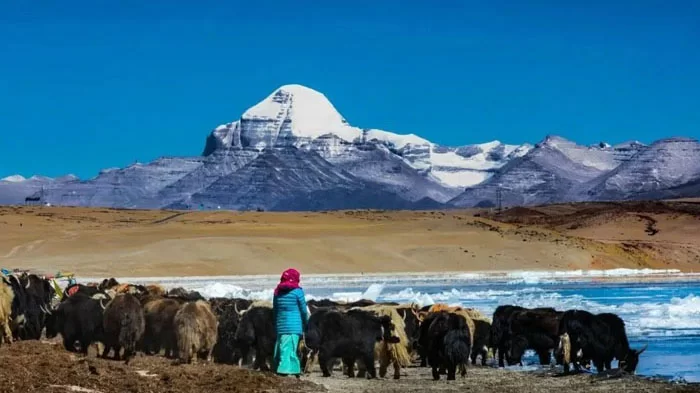 Tibetan nomad and herding yaks around the sacred Mount Kailash
Tibetan nomad and herding yaks around the sacred Mount Kailash
However, Tibetan nomads not only find ways to survive but also thrive in this inhospitable, snow-covered land. The false stereotypes depicting Tibetan nomads as barbaric and hostile are unfounded. Born in this inhospitable highland, Tibetan nomads develop the extraordinary ability to predict otherwise unpredictable weather.
In addition to their unwavering spirits, Tibetan nomads possess an innate optimistic outlook and friendly disposition. Tourists are often pleasantly surprised by the generosity and hospitality of Tibetan nomads when engaging in conversation and sharing yak butter tea in their yak-hair tents.
What is the Traditional Lifestyle of Tibetan Nomads?
Tibetan nomads have embraced a nomadic way of life for countless generations, intimately connected with the natural world and their surroundings. They primarily rely on yaks and other livestock for sustenance, and with the shifting seasons, they migrate across the vast grasslands.
Tibetan Nomad Life and Their Livestock
One of the striking characteristics of Tibetan nomads is the harmonious relationship between them and their livestock, as well as between the nomads and nature. Yaks play an indispensable role in maintaining nomads’ daily necessities. Male nomads spin yak wool into ropes and slingshots while women weave the wool into the fabric for tents, blankets, bags, and clothing.
The role of the female nomad is important in a typical nomad family and they are exceedingly versatile and hard-working. Women milk the yaks and sheep, venturing out no matter how terrible the weather is. They use milk to make yogurt, yak butter tea, and yak cheese. They also grind the barley, fetch and boil the water, weave the wool, and dry yak dung for fuel.
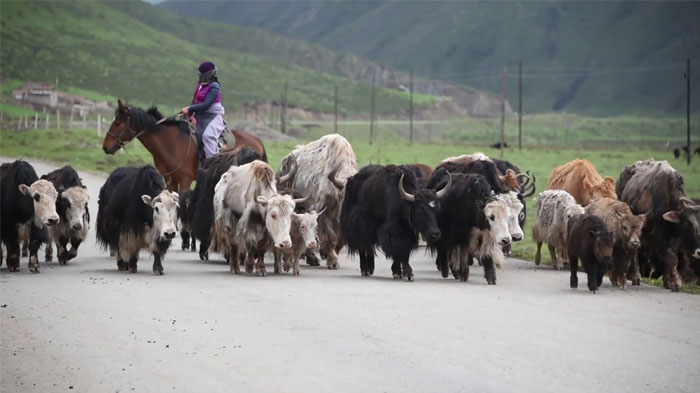 A Tibetan nomad woman herds a group of yaks.
A Tibetan nomad woman herds a group of yaks.
Even children have responsibilities, herding and feeding the livestock, and staying out in the wilderness all day without shelter from wind and rain. The male nomads may seem to be less busy most of the time, but shoulder the task of traveling outside and are in charge of buying salt and stock hay for livestock in winter, and in some cases herd livestock to town to trade it for grain and other necessities.
Tibetan Nomads and Tibetan Mastiffs
Another indispensable companion in the Tibetan Nomad’s life is the Tibetan Mastiff. Brave, fierce, and exceedingly loyal to the owner, Tibetan mastiffs have a superb memory that allows them to identify hundreds of yaks, and thousands of sheep. Tibetan mastiffs assist nomads in herding livestock, defending property, and even protecting them from wolves and other dangers.
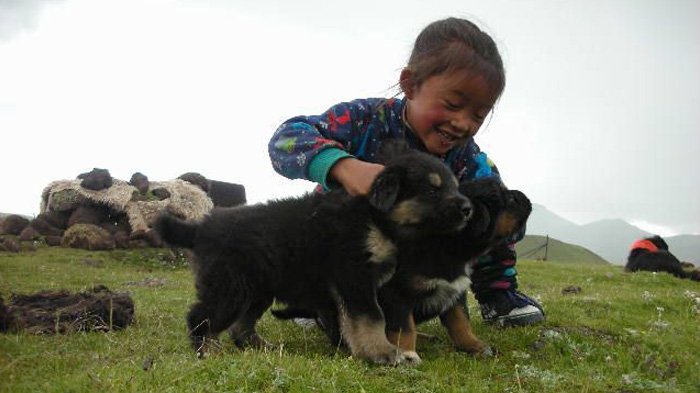 A Tibetan girl is having fun with a Tibetan Mastiff puppy.
A Tibetan girl is having fun with a Tibetan Mastiff puppy.
Tibetan nomads bring the 2-month-old pups into the family home and live with them until they are grown. As time goes by, friendship takes root between mastiffs and nomads. For those who see the Tibetan mastiffs for the first time, especially unknown tourists, it is advisable to stay away from them unless introduced. A Tibetan mastiff may see an outsider as a threat or an enemy, and an attack could be dangerous and deadly.
Tibetan Nomad Resettlement
Seasonal mobility is the biggest feature of Tibetan nomads. Each year during February and March nomads scattered in the north of Tibet will migrate down to southern pastures and spend the summer there. The nomadic caravan moves slowly and stays in place for a couple of days before moving on. The entire journey takes about three months and nomads will spend the whole summer in summer pastures and move north again in August.
Nowadays most of the nomads are semi-nomadic, and they have a permanent settlement for winter, restarting their pastoral life elsewhere as winter ends. For most nomads, a relocation takes normally 4-5 days, and can last as long as 3-4 months. The nomads can relocate their herds to follow the grazing up to ten times a year.
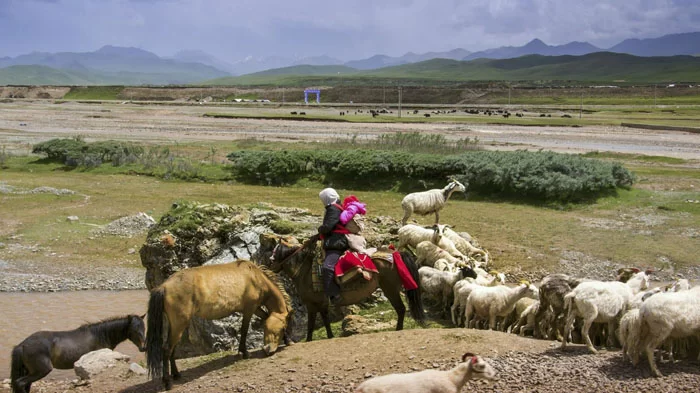 Nowadays most of the Tibetan nomads are semi-nomadic.
Nowadays most of the Tibetan nomads are semi-nomadic.
For the first move, they will invite a lama or an elder to tell the fortune and choose an auspicious date to begin the journey. Some even offer a sacrifice to the gods to pray for safety. Nomads use horses and yaks to carry tents and other large furniture. Babies are held by riders or put in a basket carried by yaks. After they arrive at the new site, the tent can be up within 3 hours and the stove and other furniture will all be in place.
Horse Racing Festivals among Tibetan Nomads
Horse racing enjoys great popularity among Tibetan nomads. Each year, horse racing competitions of all sizes are held in prairies in Tibet, and where there is a festival, there must also be horse racing. For Tibetans, horse racing is a chance for young men to display bravery and tenacity.
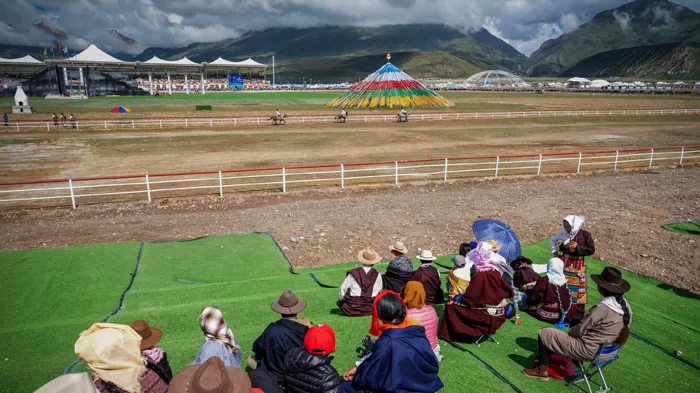 Horse racing festival is popular among Tibetan nomads.
Horse racing festival is popular among Tibetan nomads.
The festival also serves as a trade fair where they sell their own products, such as dried beef, yak butter, and natural lake salt, while buyers stock the necessities that can last for a year. As the horse racing ends, they will happily return to the prairies with their yaks loaded with ample supplies.
The most celebrated horse racing festivals are the Yushu Horse Racing Festival of Qinghai Province, the Litang Horse Racing Festival in Sichuan Province, and the Nagqu Horse Racing Festival in northern Tibet.
What about the Modern Life of Tibetan Nomads?
Nowadays, the majority of nomadic individuals have transitioned to a semi-nomadic way of life, establishing permanent settlements for the winter season. They only return to the grazing lands during the summer months.
Furthermore, government initiatives are encouraging nomads to settle in communities where they can readily access housing, healthcare, and various services.
In response to these changes, some nomads have shifted from traditional tents to brick houses. They have also diversified their income sources by providing tourism services for visitors to Tibet and selling yak byproducts.
How to Visit a Tibetan Nomad Tent?
Tibetan nomads are a major draw for tourists. As summer comes, the vast steppe turns into a massive blanket dotted with numerous flowers. Summer is the high season of travel on the prairie and tourists are also drawn to the nomadic tents.
Some business-minded nomads offer tourists accommodation and local delicacies, while others offer horseback riding on the prairie. In this way, people benefit from prairie tourism. In summer, the nomadic camps are often packed with strings of tourists who will be invited into a nomadic tent and served sweet tea, yogurt, and dried yak meat.
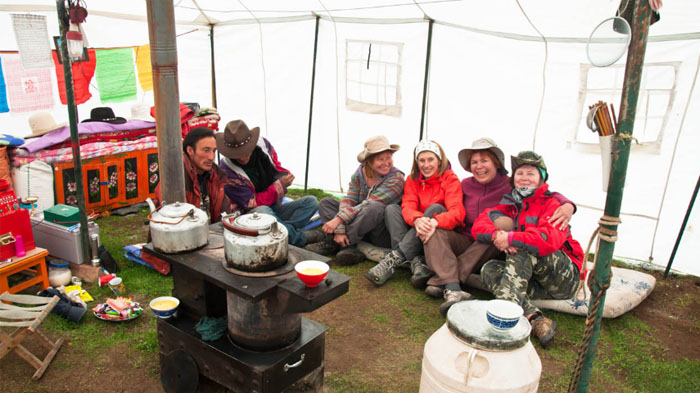 Having a rest in a Tibetan nomadic tent.
Having a rest in a Tibetan nomadic tent.
A typical nomad tent is often furnished with a stove placed in the center of the tent. In the back, there is usually a small altar with Buddhist scripture and a few butter candles. There is also a small pile of dried yak dung for fuel piled up in one corner.
When visiting a Tibetan Nomadic Tent, tourists should not place their feet towards the stove, which is believed to be sacred by nomads and you should never touch the Buddhist altar and its ornaments. Nomads are very hospitable, and they will keep refilling your cup if you finish the barley wine or yak butter tea. It is acceptable to gently advise the host that one cannot drink anymore.
How to Encounter Tibetan Nomads during a Tibet Tour?
You can meet nomads while trekking in Tibet
The grazing season usually starts in April when Tibetan nomads herd hundreds of cattle up to the hills for grazing. Though nomads travel from place to place, they are used to staying at a place rich in grass for days to feed their cattle before they move to another place near streams or better pastures. Most of them stay in a single place for a month.
From April to early October, according to the grassland location and weather, you can meet lots of nomads while traveling but if you trek in Tibet, you will have a chance for face-to-face communication with them, and be able to understand better their simple and relaxing lifestyle. The nomadic season is also the main trekking season in Tibet, and you can often meet Tibetan nomads while trekking.
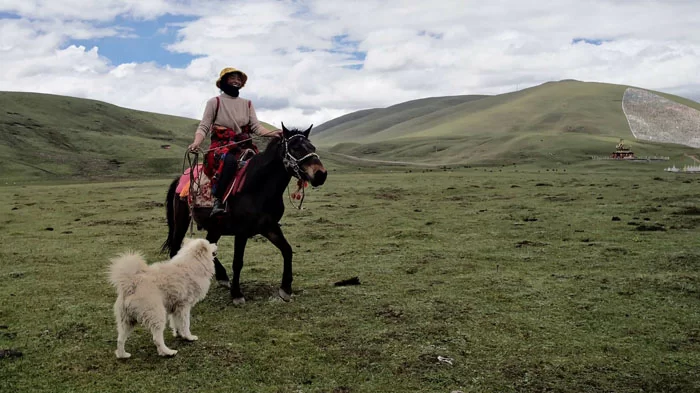 You can meet Tibetan nomads while trekking.
You can meet Tibetan nomads while trekking.
Classic trekking route to meet Tibetan nomads
A classic trek for encountering nomads is the Nyenchen Tanglha to Holy Lake-Namtso Trek. During this journey, you will traverse lush green meadows, enjoy breathtaking views of Namtso Lake, and pass through Tibetan nomad camps, where you may even have the opportunity to visit their tents.
The Ganden Monastery to Samye Monastery trek is widely known as a pilgrimage route and crosses the valleys and highland wetlands, where you can meet nomads and their cattle.
The sacred Lake Manasarovar pilgrimage trek measures 90 kilometers and it normally takes about 4 days to complete the trek. Two-thirds of the trek is close to the banks of the lake and you can enjoy the superb lake scenery on the banks of the lake and meet local nomads.
Well-known Tibetan Prairies to Meet Tibetan Nomads
When visiting the Tibetan Plateau and aiming to explore its vast grasslands, consider heading to one of the six recommended prairies as follows. These locations offer greater opportunities to encounter Tibetan nomads and their herds of animals.
Changtang Prairie
Changtang Prairie means “northern highland” in Tibetan. The prairie, one of the top five pastures in northern Tibet, lies in Nagchu Prefecture. With an average altitude of over 5000m, the Changtang prairie is dotted with highland lakes of different sizes and is known for its unrivaled grazing environment. The boundless grassland is scattered with yaks and other livestock and generations of Tibetan nomads depended on this prairie for existence. The best season to visit Changtang prairie would be in August when a series of grand traditional festivals are held in northern Tibet. It is a good time to experience the Nagqu Horse Racing Festival.
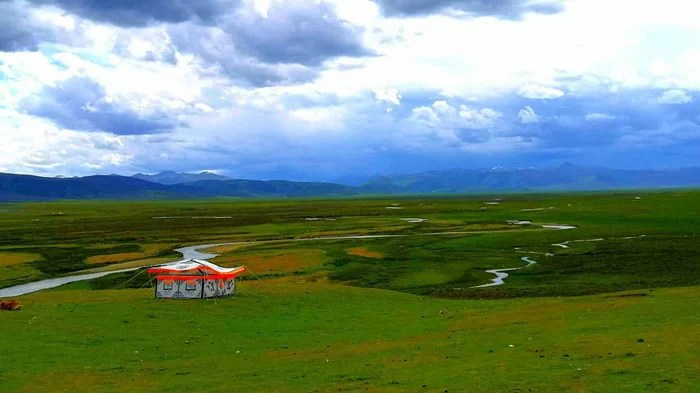 The boundless Changtang Prairie
The boundless Changtang Prairie
Ngari Prairie
The Ngari prairie lies in the northeast of Ngari Prefecture. The boundless prairie and the wilderness coexist with glaciers, alpine lakes, and mountainous ranges. Ngari prairie is a haven for wildlife and many rare species can be seen on this plain, including wild yaks, wild donkeys, Himalayan blue sheep, and wild bears. The best season to visit Ngari is from June to September when the grasslands are lush and green from the monsoon rains.
 Breathtaking Ngari prairie
Breathtaking Ngari prairie
Gannan Prairie
Gannan prairie is situated in the northeast of the plateau, with an altitude of 3,000-4,000 meters. Extremely cold and humid, the weather on the prairie is a typical alpine climate. Known for its primitiveness and mystery, Gannan Prairie is a “virgin land” with stunning alpine wetland scenery, mysterious Tibetan Buddhist monasteries, and unique local customs. The best time to visit Gannan prairie is between late August and early September.
Zoige Prairie
Zoige Prairie lies in the overlapping areas of Sichuan, Gansu, and Qinghai provinces and mainly consists of meadow steppe and swamp. The flat and immense prairie is home to many Tibetan pastoral nomads. The best time to travel in Zoige is in summer, when the hilly prairie temperature is around 10-12 degrees during the day.
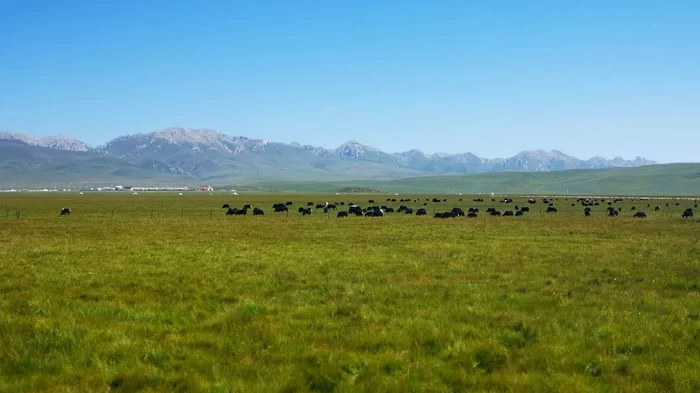 Zoige Prairie is home to many Tibetan pastoral nomads.
Zoige Prairie is home to many Tibetan pastoral nomads.
Sankoh Prairie
Sankoh prairie lies in the Xiahe region of Gannan Tibetan Autonomous Prefecture, in Gansu province. A vast meadow steppe with an average altitude of above 3,000 meters, Sankoh prairie works is one of the major suppliers of livestock products in Gannan. There are around 4000 semi-nomads living in this area and tourists can experience the grand Xianglang festival in June. Other recreational events involve horse racing, campfire dancing, shooting competitions, and so on.
Jinying Prairie
Jinying Prairie is one of the major tourist attractions in Haiyai county of Qinghai Province. Jinying means “gold and silver” in English, and the Jinying prairie is believed to be a land of abundant resources and treasure. For generations, Tibetan nomads have lived in this place and there are over 300 thousand livestock grazing on the rich grass. The best travel season is from July to September when the pastoral scenery is adorned with numerous little-known flowers and grazing livestock.
Conclusion
With so much of the Tibetan plateau being used by the nomads for their grazing, there are plenty of places to go where you can see the nomads living in harmony with their livestock and with nature. One of the most spectacular sights on the Tibetan plateau, seeing the nomadic camps with their yak hair tents and roaming mastiffs is the delight of any Tibet tour.

With exceptional passion and outstanding leadership, Mrs. Catherine has dedicated herself to Tibet inbound tourism and China tour for 15 years. As one of the handful females who see great potential of Chinese inbound tourism, Catherine has made great contribution to promoting Tibet tourism and enhancing the employment of Tibetans and prosperity of local Tibetan community.
Over the years, she travelled overseas with Tibet Tourism Bureau many times to promote Tibet tourism. Currently, Catherine works as the marketing director of Tibet Vista, an opinion leader behind the whole team of Tibet Vista.
Related Articles & Posts
Most Popular Tibet Tour Packages
-

Lhasa - Gyantse - Shigatse - Everest Base Camp - Shigatse - Lhasa
USD939
View Details -

Lhasa - Gyantse - Shigatse - E.B.C - Saga - Kailash Trek - Darchen - Lake Manasarovar - Saga - Gyirong - Tingri - Lhasa
USD2059
View Details -

10 Days Lhasa to Everest Base Camp and Namtso Lake Small Group Tour
Lhasa - Gyantse - Shigatse - EBC - Shigatse - Lhasa - Namtso Lake - Damxung - Lhasa
USD1289
View Details -

8 Days Driving Across Himalaya Overland Adventure from Kathmandu to Lhasa
Kathmandu - Gyirong - Everest Base Camp - Tingri - Shigatse - Gyantse - Lhasa
USD1069
View Details -

4 Days Lhasa Impression Small Group Tour: Explore the Heart of Tibet and Mingle with the Locals
Lhasa
USD509
View Details -

Lhasa - Gyantse - Shigatse - Everest Base Camp - Gyirong - Kathmandu
USD979
View Details -

Lhasa - Gyantse - Shigatse- Lhasa
USD799
View Details -

13 Day Lhasa, Mt. Everest, Mt. Kailash, Lake Manasarovar and Kathmandu Adventure Tour
Lhasa - Gyantse - Shigatse - EBC - Saga - Darchen - Kailash Trek - Darchen - Saga - Gyirong - Kathmandu
USD2059
View Details


.jpg)



